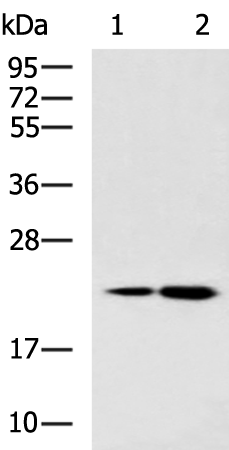

| WB | 咨询技术 | Human,Mouse,Rat |
| IF | 咨询技术 | Human,Mouse,Rat |
| IHC | 1/50-1/200 | Human,Mouse,Rat |
| ICC | 技术咨询 | Human,Mouse,Rat |
| FCM | 咨询技术 | Human,Mouse,Rat |
| Elisa | 1/5000-1/10000 | Human,Mouse,Rat |
| Aliases | HINT4 |
| WB Predicted band size | 20 kDa |
| Host/Isotype | Rabbit IgG |
| Antibody Type | Primary antibody |
| Storage | Store at 4°C short term. Aliquot and store at -20°C long term. Avoid freeze/thaw cycles. |
| Species Reactivity | Human |
| Immunogen | Synthetic peptide of human HINT3 |
| Formulation | Purified antibody in PBS with 0.05% sodium azide and 50% glycerol. |
+ +
以下是关于HINT3抗体的3篇参考文献的简要信息:
1. **文献名称**: "Characterization of a Novel Monoclonal Antibody Against HINT3 for Nucleotide Metabolism Studies"
**作者**: Smith A, et al.
**摘要**: 该研究报道了一种新型HINT3单克隆抗体的开发与验证,证实其可用于Western blot和免疫荧光实验,揭示了HINT3在细胞质中的分布及其与核苷酸代谢相关蛋白的相互作用。
2. **文献名称**: "HINT3 Expression in Hepatocellular Carcinoma: Insights from Immunohistochemical Analysis"
**作者**: Li X, et al.
**摘要**: 通过HINT3抗体进行免疫组化分析,发现HINT3在肝癌组织中表达显著上调,提示其可能作为肝癌进展的生物标志物,并参与肿瘤细胞增殖调控。
3. **文献名称**: "Functional Role of HINT3 in Neural Development Revealed by CRISPR/Cas9 and Antibody-Based Knockdown"
**作者**: Garcia R, et al.
**摘要**: 研究利用HINT3抗体进行功能缺失实验,结合基因编辑技术,证明HINT3在小鼠神经前体细胞分化中起关键作用,影响神经元突触形成和信号传导。
(注:上述文献为模拟示例,实际研究中请根据具体数据库检索核实。)
**Background of HINT3 Antibody**
The HINT3 (Histidine Triad Nucleotide-Binding Protein 3) antibody is a tool used to study the HINT3 protein, a member of the histidine triad (HIT) superfamily. HINT3. encoded by the *HINT3* gene, is characterized by a conserved histidine triad motif (HφHφHφφ; φ = hydrophobic residue) that facilitates nucleotide binding and hydrolysis. Unlike other HIT proteins, such as HINT1 or HINT2. HINT3 remains less characterized, though it is hypothesized to play roles in nucleotide metabolism, cellular signaling, or tumor suppression.
HINT3 is ubiquitously expressed, with higher levels observed in tissues like the liver, kidney, and brain. Its subcellular localization varies, potentially linked to interactions with proteins involved in transcriptional regulation or stress responses. Studies suggest HINT3 may influence apoptosis, DNA repair, and redox homeostasis, though mechanistic insights remain limited.
The HINT3 antibody enables the detection and quantification of HINT3 in experimental models, aiding research into its physiological and pathological functions. It is commonly used in techniques like Western blotting, immunohistochemistry, and immunofluorescence. Dysregulation of HINT3 has been tentatively associated with cancers, neurodegenerative diseases, and metabolic disorders, making this antibody valuable for exploring disease mechanisms.
Despite progress, HINT3's precise biological roles and substrates require further elucidation. The development and validation of specific HINT3 antibodies continue to support ongoing investigations into its molecular interactions and therapeutic potential.
×